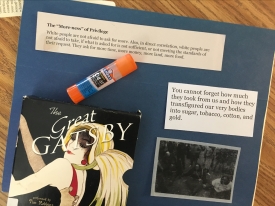Qualifier for this post: It is not about RWW per se. Through my own fault, my AP Language & Comp students rarely have any choice about what they read and write (next year. sigh.) But I think what I describe in this post could be adapted pretty easily for the RWW classroom.
I’m teaching The Great Gatsby for the 17th time. Over the years, I’ve gone the route of color imagery analysis, character analysis, stylistic analysis, and yes, the novel’s commentary on the American Dream. The latter option, this year, fills me with nothing but dread for political reasons I probably don’t have to explain to anyone reading this blog. But my dread is also based in an ongoing (and growing) sense of complex arguments becoming grossly oversimplified: We either “Like” something, or we “Unfollow” it. C haracters are either “normal” (Nick), or they are psychopaths (George Wilson). You’re either with us, or you’re with the terrorists. Me Tarzan, You Jane.
haracters are either “normal” (Nick), or they are psychopaths (George Wilson). You’re either with us, or you’re with the terrorists. Me Tarzan, You Jane.
Most ideas or issues are more complicated than simply “either” one thing “or” another. Obv, right? My AP students are learning the importance of making complex meaning from what they read and expressing their understanding of an issue in complex ways by qualifying their own or their understanding of others’ arguments. To that end, I’d like to recommend the process of “iterative collaging,” which I learned about at NCTE last fall from a session given by Andrea Avery, Nishta Mehra, and Courtney Rath.
As we’re reading, we’re discussing themes of capitalism and class structure, freedom and  oppression, and the omnipresent concept of the American Dream. We’ve examined images from media as well as the writing of Ta-Nehisi Coates surrounding these issues. Right now, ideas are plentiful and scattered. Ultimately, though, by arranging these images and passages in certain ways, students will compose a visual argument about the interaction of these issues in the America they know. But here’s the cool part — and the iterative part: Using some magic in the form of repositionable glue sticks (yes, those are a thing — see photo!), students can arrange and rearrange the items in their collage to explore the ways various juxtapositions can reveal new understandings. AND — Maguire hopes — discover complex meanings beyond the reductive arguments that plague so much of our current discourse.
oppression, and the omnipresent concept of the American Dream. We’ve examined images from media as well as the writing of Ta-Nehisi Coates surrounding these issues. Right now, ideas are plentiful and scattered. Ultimately, though, by arranging these images and passages in certain ways, students will compose a visual argument about the interaction of these issues in the America they know. But here’s the cool part — and the iterative part: Using some magic in the form of repositionable glue sticks (yes, those are a thing — see photo!), students can arrange and rearrange the items in their collage to explore the ways various juxtapositions can reveal new understandings. AND — Maguire hopes — discover complex meanings beyond the reductive arguments that plague so much of our current discourse.
We’re in the early stages of this work — hence, the in-progress photo — but I will surely let you know how it goes. Has anyone out there ever used collage for argument (or, any other fun reason)?

>
LikeLike
I am SUPER INTERESTED in this!! I’d love to know more & can’t wait to see the results!
LikeLike